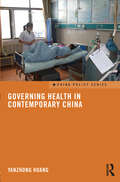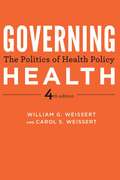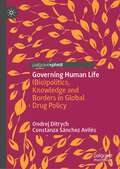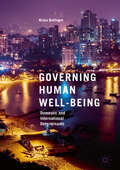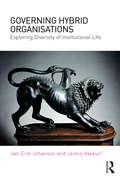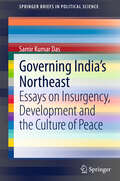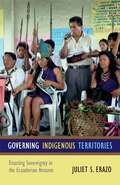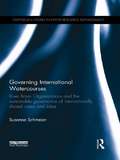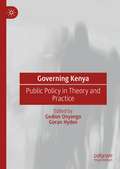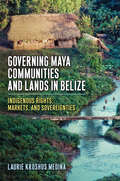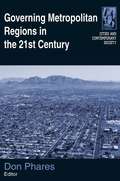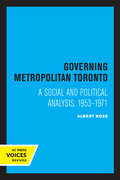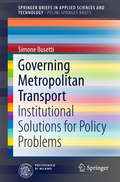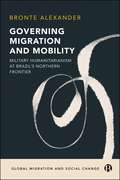- Table View
- List View
Governing Health in Contemporary China (China Policy Series)
by Yanzhong HuangThe lack of significant improvement in people’s health status and other mounting health challenges in China raise a puzzling question about the country’s internal transition: why did the reform-induced dynamics produce an economic miracle, but fail to reproduce the success Mao had achieved in the health sector? This book examines the political and policy dynamics of health governance in post-Mao China. It explores the political-institutional roots of the public health and health care challenges and the evolution of the leaders’ policy response in contemporary China. It argues that reform-induced institutional dynamics, when interacting with Maoist health policy structure in an authoritarian setting, have not only contributed to the rising health challenges in contemporary China, but also shaped the patterns and outcomes of China’s health system transition. The study of China’s health governance will further our understanding of the evolving political system in China and the complexities of China’s rise. As the world economy and international security are increasingly vulnerable to major disease outbreaks in China, it also sheds critical light on China’s role in global health governance.
Governing Health: The Politics of Health Policy
by William G. Weissert Carol S. WeissertGoverning Health examines health care policy from a political perspective, describing how Congress, the president, special interest groups, bureaucracy, and state governments help define health policy problems and find politically feasible solutions. William G. Weissert and Carol S. Weissert provide a highly readable and comprehensive synthesis of political science research on how government and private institutions affect the policy process. Extensive reviews of the policies that have governed health care since Lyndon Johnson's administration are capped off with a prognosis for the future. Updates to the fourth edition of Governing Health include - new examples and theory perspectives- recent statistics- discussion of the 2010 Obama health reform
Governing Health: The Politics of Health Policy
by William G. Weissert Carol S. WeissertHow do government and private interests shape the health policy process?In this classic text, William G. Weissert and Carol S. Weissert describe how government and private interests help define health policy. Under the Obama administration, the federal government took a broadened role in setting health policy and insurance regulations. But the succeeding Trump administration and a Republican congress threatened to dismantle the Affordable Care Act (ACA) and its core tenets. Chronicling these recent important changes, Governing Health explores the political science theory behind this and other major shifts in national health policy.In this thoroughly updated edition, the authors describe how party polarization, a virulent anti-government movement, populist presidential politics, and the demise of "regular order" in Congress shape and define a new approach to health policy. This revised edition also• offers a comprehensive synthesis of Obamacare, touching on everything from Accountable Care and Pay for Performance to insurance industry reforms • highlights the important role of social media in building opposition to universal coverage• tracks passage of the new Medicare physician payment reform, MACRA• analyzes presidential executive orders and administrative rulemaking in dismantling the Affordable Care Act• examines the implications of Supreme Court decisions on Medicaid expansion and state health policy • updates all statistics, charts, and tablesThis new edition of a highly respected book guides readers toward a deep understanding of modern health policy's complexities. Drawing on compelling current examples, Governing Health is a timely and essential book.
Governing Human Life: (Bio)politics, Knowledge and Borders in Global Drug Policy
by Ondrej Ditrych Constanza Sánchez AvilésThis book presents an analysis tracing the operation of biopolitical mode of power in the global field of drug control. Through a series of theoretically framed investigations that relate current drug control policies to the broader frame of ‘vital politics,’ it attends to the relationship of drug control, democracy and authoritarianism and showcases these pressures on the case of the evolution of drug policy in the Czech Republic. Then, it turns attention to the relationship of power and knowledge, with a particular focus on ‘evidence-based’ policy that tends to more often sustain, rather than challenge coercive and punitive drug control policies. Last but not least, it looks at how the global drug control dispositif shapes those lives on one of Europe’s (internal) periphery, the Spanish Southern border. These investigations are intended to illuminate elements of the operation of the drug control dispositif and its far reaching (bio-)political effects in order to maintain and expand the space for thinking political alternatives.
Governing Human Well-Being
by Nisha BellingerThis book provides a comprehensive explanation of human well-being outcomes by analyzing the role of domestic and international political factors. The well-being outcomes under study are the building blocks of development, and play a crucial developmental role in the lives of citizens, states, and the global community. The project introduces cases from Brazil, Japan, China, and Iraq, and proposes to answer some of the pressing questions that scholars and policy-makers alike have pondered over for years. Why are there large disparities between countries in the quality of life people lead? What factors account for the general well-being of mankind? How do we improve human lives?
Governing Hybrid Organisations: Exploring Diversity of Institutional Life
by Jan-Erik Johanson Jarmo VakkuriIntuitively, organisations can easily be categorised as ‘public’ or ‘private’. However, this book questions such a black and white dichotomy between public and private, and seeks a deeper understanding of hybrid organisations. These organisations can be found at micro, meso and macro levels of societal activity, consisting of networks between companies, public agencies and other entities. The line between these two realms is increasingly blurred — giving rise to hybrid organisations. Governing Hybrid Organisations presents an engaging discussion around hybrid organisations, highlighting them as important and fascinating examples of modern institutional diversity. Chapters examine the changing landscape of service delivery and the nature and governance of hybrid organisations, using international examples and cases from different service contexts. The authors put forward a clear analytical framework for understanding hybrid governance, looking at strategy and performance management. This text will be valuable for students of public management, public administration, business management and organisational studies, and will also be illuminating for practising managers.
Governing India's Northeast
by Samir Kumar DasThis book focuses on issues of governance and the nature and complexities of social transformation in India's Northeast -- a 'problem' zone for policymakers -- particularly since the early 1990s. While governance is the thread that runs through the volume, the latter at one level addresses the challenges of governing in global times a region historically marked by acute violence, interethnic conflict and insurgency; and at another, traces macro changes in the very forms and technologies of governance. The essays in this volume point to how changing forms and technologies of governing insurgency, development and culture do not remain mere instruments of peace, but define the very nature and content of both peace and conflict and their interrelationship in the region.For the first time in the history of scholarship on the region, the three crucial issues of insurgency, development and culture have been analysed through the lens of governance. This volume, therefore, marks an important addition to the scholarship on the region.
Governing Indigenous Territories: Enacting Sovereignty in the Ecuadorian Amazon
by Erazo Juliet S.Governing Indigenous Territories illuminates a paradox of modern indigenous lives. In recent decades, native peoples from Alaska to Cameroon have sought and gained legal title to significant areas of land, not as individuals or families but as large, collective organizations. Obtaining these collective titles represents an enormous accomplishment; it also creates dramatic changes. Once an indigenous territory is legally established, other governments and organizations expect it to act as a unified political entity, making decisions on behalf of its population and managing those living within its borders. A territorial government must mediate between outsiders and a not-always-united population within a context of constantly shifting global development priorities. The people of Rukullakta, a large indigenous territory in Ecuador, have struggled to enact sovereignty since the late 1960s. Drawing broadly applicable lessons from their experiences of self-rule, Juliet S. Erazo shows how collective titling produces new expectations, obligations, and subjectivities within indigenous territories.
Governing Insecurity in Japan: The Domestic Discourse and Policy Response (The University of Sheffield/Routledge Japanese Studies Series)
by Reinhard Drifte Wilhelm Vosse Verena Blechinger-TalcottSince the end of the Cold War, Japan's security environment has changed significantly. While, on the global level, the United States is still Japan's most important security partner, the nature of the partnership has changed as a result of shifting demands from the United States, new international challenges such as the North Korean nuclear programme and the rapid rise of China. At the same time, Japan has been confronted with new, ‘non-traditional’ security threats such as international terrorism, the spread of infectious diseases, and global environmental problems. On the domestic level, demographic change, labour migration, economic decline, workplace insecurity, and a weakening impact of policy initiatives challenge the sustainability of the lifestyle of many Japanese and have led to a heightened sense of insecurity among the Japanese public. This book focuses on the domestic discourse on insecurity in Japan and goes beyond military security. The chapters cover issues such as Japan’s growing perception of regional and global insecurity; the changing role of military forces; the perceived risk of Chinese foreign investment; societal, cultural and labour insecurity and how it is affected by demographic changes and migration; as well as food insecurity and its challenges to health and public policy. Each chapter asks how the Japanese public perceives these insecurities; how these perceptions influence the public discourse, the main stakeholders of this discourse, and how this affects state-society relations and government policies. Governing Insecurity in Japan provides new insights into Japanese and international discourses on security and insecurity, and the ways in which security is conceptualized in Japan. As such, it will be of interest to students and scholars working on Japanese politics, security studies and international relations.
Governing International Labour Migration: Current Issues, Challenges and Dilemmas (RIPE Series in Global Political Economy #Vol. 26)
by Christina Gabriel Hélène PellerinThis book offers a critical examination of the way in which the nature and governance of international labour migration is changing within a globalizing environment. It examines how labour mobility and the governance of labour migration are changing by exploring the links between political economy and differentiated forms of labour migration. Additionally, it considers the effects of new social models of inclusion and exclusion on labour migration. Therefore, the book troubles the conventional dichotomies and categorizations – permanent vs. temporary; skilled vs. unskilled; legal vs. illegal -- that have informed migration studies and regulatory frameworks. Theoretically, this volume contributes to an ongoing project of reframing the study of migration within politics and international relations. Bringing together an interdisciplinary group of scholars, drawing on examples from the European Union, North America and Asia, Governing International Labour Migration will be of interest to students and scholars of migration studies, IPE, international relations, and economics.
Governing International Watercourses: River Basin Organizations and the Sustainable Governance of Internationally Shared Rivers and Lakes (Earthscan Studies in Water Resource Management)
by Susanne SchmeierThis book focuses on River Basin Organizations as the key institutions for managing internationally shared water resources. This includes a comparative analysis of all River Basin Organizations worldwide and three in-depth case studies from three different continents. The detailed case studies are the Senegal (West Africa), Mekong (South-east Asia) and Danube (Europe) rivers. The book contributes to the academic debate on how shared natural and environmental resources can be managed in a sustainable way and which institutional and legal mechanisms actually matter for doing so. It adopts the neo-institutionalist approach, according to which international environmental institutions do make a difference. The analysis not only confirms this argument for the specific case of shared water resources, but also refines existing hypotheses on the influence of different independent variables, namely the nature of the collective action problem, the constellation of actors and the institutional design of an international environmental institution. The work also contributes to the policy debate on how to better govern internationally shared natural resources and the environment. It provides policy makers with advice on which exogenous conditions to be aware of when managing water resources they share with co-riparians and which institutional design features and governance mechanisms to set up in order to increase effectiveness in management.
Governing Islam Abroad: Turkish And Moroccan Muslims In Western Europe (The\sciences Po Series In International Relations And Political Economy Ser.)
by Benjamin BruceFrom sending imams abroad to financing mosques and Islamic associations, home states play a key role in governing Islam in Western Europe. Drawing on over one hundred interviews and years of fieldwork, this book employs a comparative perspective that analyzes the foreign religious activities of the two home states with the largest diaspora populations in Europe: Turkey and Morocco. The research shows how these states use religion to promote ties with their citizens and their descendants abroad while also seeking to maintain control over the forms of Islam that develop within the diaspora. The author identifies and explains the internal and foreign political interests that have motivated state actors on both sides of the Mediterranean, ultimately arguing that interstate cooperation in religious affairs has and will continue to have a structural influence on the evolution of Islam in Western Europe.
Governing Israel: Chosen People, Promised Land and Prophetic Tradition
by Ira SharkanskyIsraeli politics and policymaking reflect themes long imbedded in Jewish culture. The concepts of Chosen People and Promised Land, and their meaning in Christian as well as Jewish religious traditions, assure that Israel is perpetually in the international spotlight. They also impose a sense of distinctiveness on the Israeli population. Some Israelis trumpet their country's accomplishments with unrestrained superlatives. Social critics accuse Israel of having the worst of the world's conditions. In this they reflect another trait that seems to have been inherited from the ancients: the prophetic tradition of extreme self-criticism. In reality, much of what occurs in Israel is similar to what occurs in countries that share its characteristics: democracy, western culture, and an advanced level of economic development. Such an idea may seem bizarre alongside headlines about suicide bombings and the country's aggressive defensive posture. This misses what is normal about Israel. In Israel policymakers weigh benefits and costs of various options, and generally choose something moderate, just as they do elsewhere. But this reality does not dim the rhetoric of politics, where hyperbole frequently seems more evident than rational discourse. Sharkansky discusses three central issues in Israeli public affairs: religion, national security, and social policy. He describes how policymakers relate to these issue and themes. Major problems may not be solved, but they are managed in a way that is tolerable. It is in this trait that Israel resembles other western democracies. In sum, biblical themes affect Israel's political rhetoric more than they affect the way officials actually work out their problems. Pragmatic coping with worldly realities generally overcomes emotional expressions that convey ingredients of spirituality.
Governing Kenya: Public Policy in Theory and Practice
by Goran Hyden Gedion OnyangoThis book is authored by some of the renowned scholars in Africa who take on the task to understand how Kenya is governed in this century from a public policy perspective. The book’s public policy approach addresses three general and pertinent questions: (1) how are policies made in a political context where change is called for, but institutional legacies tend to stand in the way? (2) how are power and authority shared among institutional actors in government and society? and, (3) how effective is policymaking at a time when policy problems are becoming increasingly complex and involving multiple stakeholders in Africa? This book provides an updated and relevant foundation for teaching policy, politics and administration in Kenya. It is also a useful guide for politicians, the civil society, and businesses with an interest in how Kenya is governed. Furthermore, it addresses issues of comparability: how does the Kenyan case fit into a wider African context of policymaking? ‘This volume is a major contribution to comparative policy analysis by focusing on the policy processes in Kenya, a country undergoing modernization of its economic and political institutions. Written by experts with a keen eye for the commonalities and differences the country shares with other nations, it covers a range of topics like the role of experts and politicians in policymaking, the nature of public accountability, the impact of social media on policy actors, and the challenges of teaching policy studies in the country. As a first comprehensive study of an African nation, Governing Kenya will remain a key text for years to come’. —Michael Howlett, Burnaby Mountain Chair of Political Science, Simon Fraser University, Canada ‘A superb example of development scholarship which sets aside ‘best practice’ nostrums and focuses on governance challenges specific to time and place while holding on to a comparative perspective. Useful to scholars and practitioners not only in Kenya but across developing areas. I strongly recommend it!’ —Brian Levy teaches at the School of Advanced International Studies, Johns Hopkins University, USA, and the University of Cape Town, South Africa. ‘This book is an exploration of important deliberations - of interest for those of us interested in deepening the understanding of public policy theories and their application within a specific African setting’. —Wilson Muna, Lecturer of Public Policy, Kenyatta University, Nairobi, Kenya ‘This collection of think pieces on public policy in Kenya gives the reader theoretical and practical hooks critical to the analysis of the implementation of the sovereign policy document in Kenya, the 2010 Constitution’. —Willy Mutunga, Chief Justice & President of the Supreme Court, Republic of Kenya, 2011-2016 ‘Governing Kenya provides a comprehensive analysis of public policymaking in Kenya. The book integrates public policy theory with extensive empirical examples to provide a valuable portrait of the political and economic influences on policy choices in this important African country. The editors have brought together a group of significant scholars to produce an invaluable contribution to the literature on public policy in Africa’. —B. Guy Peters, Maurice Folk Professor of American Government, University of Pittsburgh, USA
Governing Literate Populations: The Political Uses of Literacy in Securing Civil Society (Routledge Research in Education)
by Stephen KellySecuring the hearts and minds of ‘dangerous’ populations is a major concern for governments across the world. Governing Literate Populations shows how ‘governmentalities’ have deployed education and literacy in different ways in order to protect their national, social, economic and geopolitical security interests. Presenting a Foucauldian Genealogy of literacy and education, Kelly argues that government apparatuses strategically contain the rise of complex social forces to protect homogenous cultural values. Kelly’s work traces the development of the relationship between liberal governmentalities and the securitization of ‘martial’ literate citizenries from its beginnings in the Enlightenment, starting with Hobbes’ Leviathan in 1651, through to the emergence of human security in 1994. He then examines the situation in Australia from 1995-2007, investigating political statements by the Howard Government and the insurgent Rudd opposition against the backdrop of the ‘age of terror’. The conclusion takes another historical cut by considering how the political uses of literacy can be located in the texts of Plato, before examining how the conceptualization of literate subject as citizen of the state has come to be realized in the United Kingdom and the United States of America. Governing Literate Populations draws on data obtained from historical texts, including political and economic treatises, publications by NGOS, media sites, government policies and archived political speeches. As such, it will appeal to academics, researchers and postgraduate students examining education policy and the political uses of education, as well as literacy education and the history of education. Those with an interest in politics, sociology and history will also find this work a highly informative resource.
Governing Maya Communities and Lands in Belize: Indigenous Rights, Markets, and Sovereignties
by Laurie Kroshus MedinaConfronting a debt crisis, the Belizean government has strategized to maximize revenues from lands designated as state property, privatizing lands for cash crop production and granting concessions for timber and oil extraction. Meanwhile, conservation NGOs have lobbied to establish protected areas on these lands to address a global biodiversity crisis. They promoted ecotourism as a market-based mechanism to fund both conservation and debt repayment; ecotourism also became a mechanism for governing lands and people—even state actors themselves—through the market. Mopan and Q’eqchi’ Maya communities, dispossessed of lands and livelihoods through these efforts, pursued claims for Indigenous rights to their traditional lands through Inter-American and Belizean judicial systems. This book examines the interplay of conflicting forms of governance that emerged as these strategies intersected: state performances of sovereignty over lands and people, neoliberal rule through the market, and Indigenous rights-claiming, which challenged both market logics and practices of sovereignty.
Governing Megacities in Emerging Countries
by Dominique LorrainMegacities are a new phenomenon in history. The fact that many of them are in emerging countries deepens the challenges of governing these spaces. Can these vast, complex entities, rife with inequalities and divisions, be governed effectively? For researchers, the answer has often been no. The approach developed in this work focuses on the material city and its institutions and shows that, without recourse to a big new theory, urban leaders have devised mechanisms of ordinary government. They have done so through the resolution of practical and essential problems: providing electricity, drinking water, sanitation, transportation. Three findings emerge from this book. Infrastructure networks help to structure cities and function as mechanisms of cohesion. Megacities become more governable if there is a legitimate authority capable of making choices. Finally, anarchic urbanisation has its roots in systems of land ownership, in inadequate urban planning and in the practices of developers and local actors. In the originality of its hypotheses and the precision of the analyses carried out in the four case study cities of Shanghai, Mumbai, Cape Town and Santiago de Chile, this work is addressed to all those interested in the life of cities: politicians, local and central government officials, executives in urban companies, researchers and students.
Governing Metropolitan Areas: Growth and Change in a Networked Age
by David K. HamiltonInterest and research on regionalism has soared in the last decade. Local governments in metropolitan areas and civic organizations are increasingly engaged in cooperative and collaborative public policy efforts to solve problems that stretch across urban centers and their surrounding suburbs. Yet there remains scant attention in textbooks to the issues that arise in trying to address metropolitan governance. Governing Metropolitan Areas describes and analyzes structure to understand the how and why of regionalism in our global age. The book covers governmental institutions and their evolution to governance, but with a continual focus on institutions. David Hamilton provides the necessary comprehensive, in-depth description and analysis of how metropolitan areas and governments within metropolitan areas developed, efforts to restructure and combine local governments, and governance within the polycentric urban region.This second edition is a major revision to update the scholarship and current thinking on regional governance. While the text still provides background on the historical development and growth of urban areas and governments' efforts to accommodate the growth of metropolitan areas, this edition also focuses on current efforts to provide governance through cooperative and collaborative solutions. There is also now extended treatment of how regional governance outside the United States has evolved and how other countries are approaching regional governance.
Governing Metropolitan Indianapolis: The Politics of Unigov (Lane Studies in Regional Government)
by C. James Owen York WillbernThis title is part of UC Press's Voices Revived program, which commemorates University of California Press’s mission to seek out and cultivate the brightest minds and give them voice, reach, and impact. Drawing on a backlist dating to 1893, Voices Revived makes high-quality, peer-reviewed scholarship accessible once again using print-on-demand technology. This title was originally published in 1985.
Governing Metropolitan Regions in the 21st Century (Cities And Contemporary Society Ser.)
by Donald PharesWhile government provides the structure of public leadership, governance is the art of public leadership. This timely book examines current trends in metropolitan governance issues. It analyzes specific cases from thirteen major metropolitan regions in the United States, Canada, and Mexico, all woven together by an overall framework established in the first three chapters. The distinguished contributors address such governance issues as city-county consolidation, local-federal coordination, annexation and special districting, and private contracting, with special attention to lessons learned from both successes and failures. As urban governance innovations have clearly outpaced urban government structures in recent years, the topics covered here are especially relevant.
Governing Metropolitan Toronto: A Social and Political Analysis, 1953 - 1971
by Albert RoseThis title is part of UC Press's Voices Revived program, which commemorates University of California Press’s mission to seek out and cultivate the brightest minds and give them voice, reach, and impact. Drawing on a backlist dating to 1893, Voices Revived makes high-quality, peer-reviewed scholarship accessible once again using print-on-demand technology. This title was originally published in 1972.
Governing Metropolitan Transport
by Simone BusettiThis book investigates the link between institutions and public policies with specific reference to transport. It opens by examining the main arguments for the establishment of metropolitan transport authorities. The potential impacts of institutional change on the policy efficiency of institutions are then examined. Key problems for institutional designers are identified, showing how they can hamper the achievement of desired policy outcomes through institutional solutions. Two in-depth case studies on institutional change in metropolitan transport (in London and Barcelona) are presented with a view to testing the aforementioned hypotheses and providing insights into the ways in which the two transport institutions were reformed. The concluding chapter identifies lessons for institutional designers and highlights the policy results that may be expected from the constitution of metropolitan transport authorities.
Governing Migration and Mobility: Military-Humanitarianism at Brazil's Northern Frontier (Global Migration and Social Change)
by Bronte AlexanderAs the world faces unprecedented levels of displacement with over 100 million people forced to flee conflict, economic instability and climate crises, responses to migration have become increasingly complex. This book examines the military-humanitarian strategies used to manage the movement of people on the move, focusing on the migration of Venezuelans to northern Brazil. By developing the concept of ‘debilitating mobilities,’ the book explores mobility governance through border security, urban control and shelter provision. Shedding light on the intersecting logics of aid, security and vulnerability, this book reveals the multiscalar governance of migration in precarious environments.
Governing Military Technologies in the 21st Century: Ethics and Operations
by Richard Michael O’mearaGoverning Military Technologies in the 21st Century is one of the first books to tackle the big five technological threats all in one place: nanotech, robotics, cyberwar, human enhancement, and, non-lethal weapons, weaving a historical, legal, and sociopolitical fabric into a discussion of their development, deployment, and, potential regulation.
Governing Mobility Beyond the State: Centre, Periphery and the EU's External Borders (Palgrave Studies in European Political Sociology)
by Andreas MüllerThis book explores the structural tensions and conflicts that arise with the abolition of border controls between the EU's member states and how this conflict ridden relationship affects and is affected by the institutional shape of the EU's external borders.
